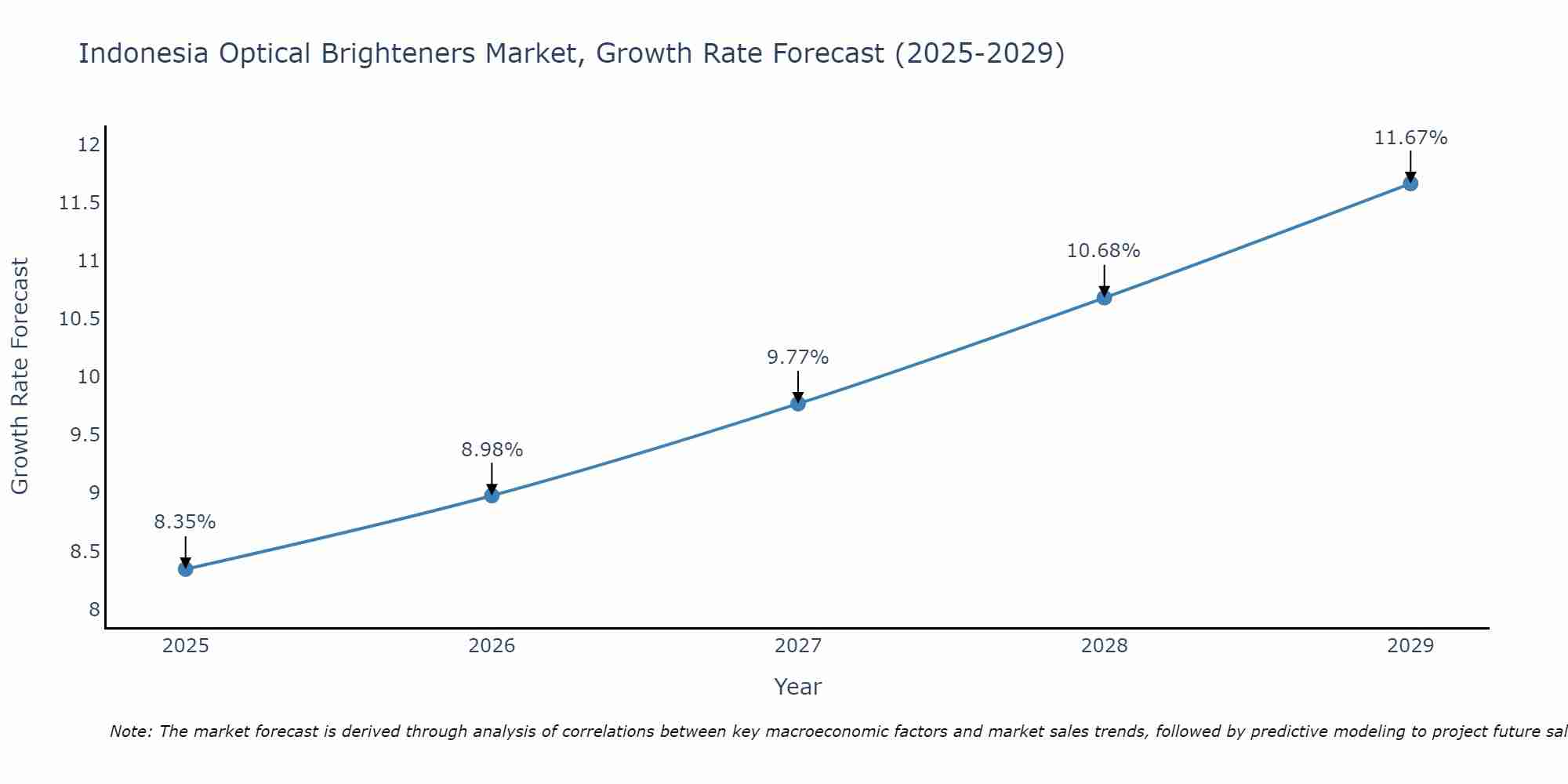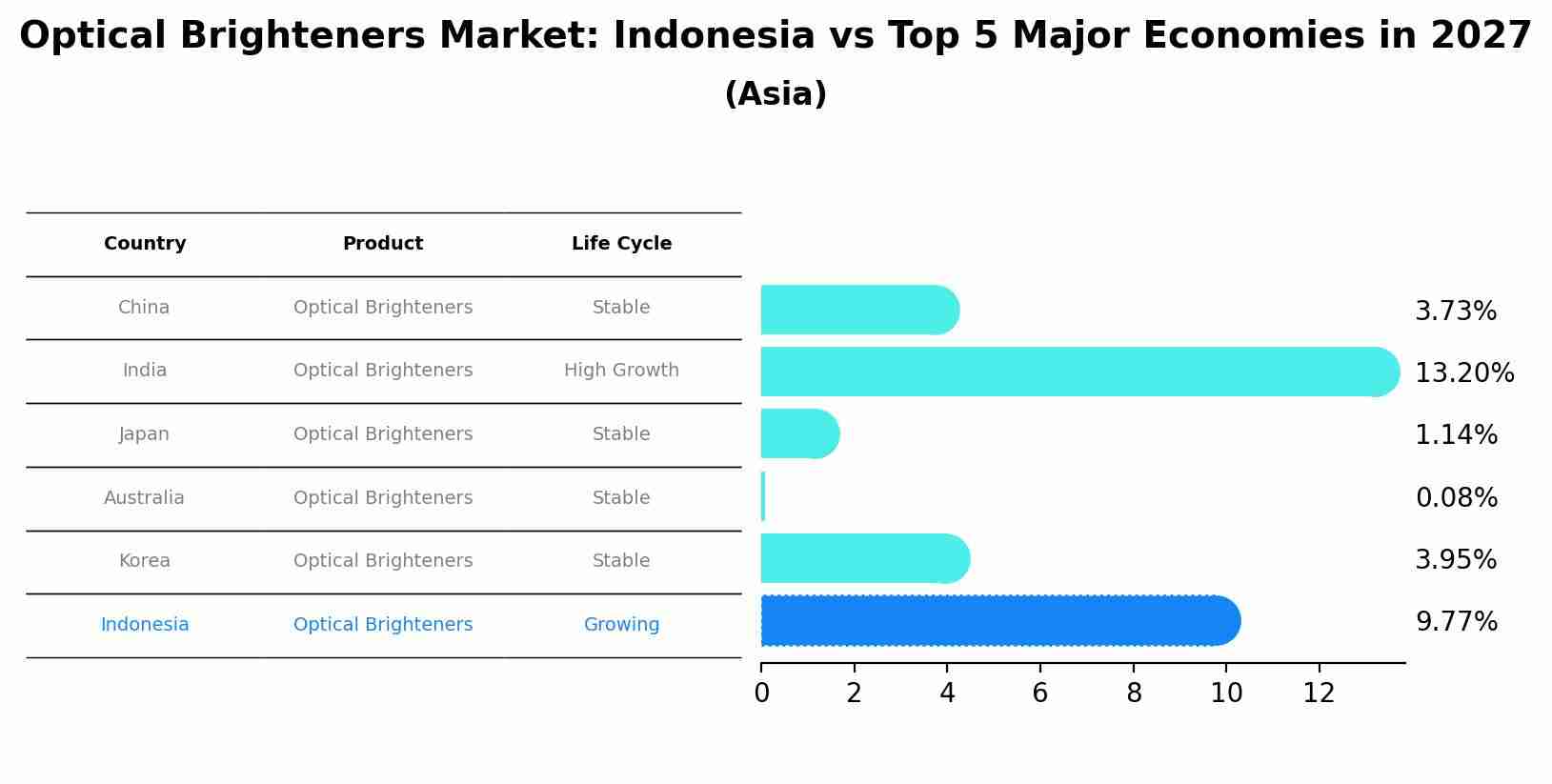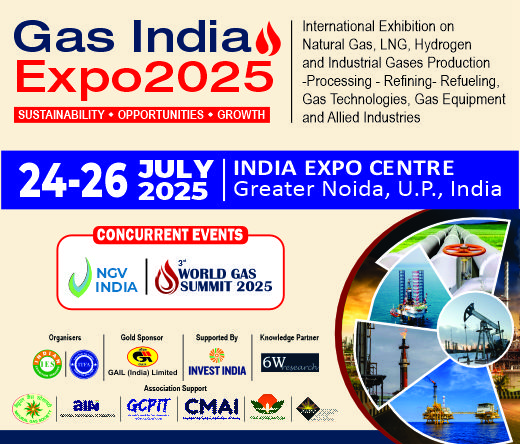Indonesia Optical Brighteners Market (2025-2031) Outlook | Value, Trends, Share, Forecast, Size, Analysis, Industry, Growth, Revenue & Companies
| Product Code: ETC091967 | Publication Date: Jul 2023 | Updated Date: Apr 2025 | Product Type: Report | |
| Publisher: 6Wresearch | No. of Pages: 70 | No. of Figures: 35 | No. of Tables: 5 | |
Indonesia Optical Brighteners Market Size Growth Rate
The Indonesia Optical Brighteners Market is poised for steady growth rate improvements from 2025 to 2029. Commencing at 8.35% in 2025, growth builds up to 11.67% by 2029.

Optical Brighteners Market: Indonesia vs Top 5 Major Economies in 2027 (Asia)
Indonesia's Optical Brighteners market is anticipated to experience a growing growth rate of 9.77% by 2027, reflecting trends observed in the largest economy China, followed by India, Japan, Australia and South Korea.

Indonesia Optical Brighteners MarketSynopsis
The optical brighteners market in Indonesia is estimated to witness a positive growth rate over the forecast period owing to increasing awareness regarding the importance of fabric whitening agents, rising demand for apparel products and growing population. Furthermore, various product innovations by leading players coupled with advancements in technology are expected to further contribute towards the growth of this market. Additionally, increasing cost pressure from buyers is forcing manufacturers to focus on improving their production process which could subsequently boost this market?s growth.
Market Trends
Some of the key trends observed in the Indonesia optical brightener industry are preference for eco-friendly products, increased use of fluorescent dyes for laundry detergent applications and development and adoption of advanced technologies such as thin film coating techniques. The inclusion of these techniques helps manufacturers improve their production rates while also providing superior quality results. Moreover, recent technological developments have enabled producers to produce more concentrated solutions that reduce waste generation during manufacturing processes which has been beneficial for both industries and consumers alike.
Market Drivers
Some of the major drivers behind the growth of Indonesia optical brighteners market include an increase in disposable income among urban consumers coupled with higher purchasing power parity (PPP). This has created greater demand for clothing items such as denim jeans that require efficient fabric whitening agents thus driving up sales volume within this sector. In addition, new product launches from players such as Huntsman Corporation along with government initiatives encouraging sustainable practices have all contributed towards driving up revenue generated by this industry segment over time.
COVID-19 Impact on the Market
The outbreak of COVID-19 pandemic had a significant impact on global economies including Indonesia economy due to its varied implications across multiple sectors. With respect to optical brighteners, it was seen that there was a considerable decline in demand from textile industries due vendors facing disruption caused by lockdowns implemented worldwide. Moreover, restrictions imposed on transportation networks led to delayed shipments thereby affecting packaging material supplies. However, despite challenges faced at present, experts indicate that once normalcy returns ,the markets will revive gradually making way for future opportunities associated with increased utilization related activities within respective segments.
Challenges of the Market
The main challenge faced by companies operating within Indonesia Optical Brightener industry is sustainability issues arising out potential environmental pollution posed through wastewater disposal related problems associated with inadequate infrastructure facilities available nationwide. Due to high cost associated with producing optical brighteners, it is difficult for manufacturers to offer competitive prices which can result in lower sales volume as compared with other markets. Low awareness among Indonesia consumers about the various applications of optical brightening agents poses a challenge for its adoption by end users. Poor infrastructure such as inadequate electricity supply and lack of transportation facilities act as roadblocks in supplying these materials from one place to another.
Industry Key Players
Some key players operating in the Indonesia Optical Brightener Market include BASF SE, Huntsman Corporation (Avery Dennison), Sumitomo Chemicals Co., Ltd., Clariant International AG, Arkema Group Sdn Bhd, Eckart GmbH & Co KG, DIC Corporation and others.
Key Highlights of the Report:
- Indonesia Optical Brighteners Market Outlook
- Market Size of Indonesia Optical Brighteners Market, 2024
- Forecast of Indonesia Optical Brighteners Market, 2031
- Historical Data and Forecast of Indonesia Optical Brighteners Revenues & Volume for the Period 2021-2031
- Indonesia Optical Brighteners Market Trend Evolution
- Indonesia Optical Brighteners Market Drivers and Challenges
- Indonesia Optical Brighteners Price Trends
- Indonesia Optical Brighteners Porter's Five Forces
- Indonesia Optical Brighteners Industry Life Cycle
- Historical Data and Forecast of Indonesia Optical Brighteners Market Revenues & Volume By Chemical for the Period 2021-2031
- Historical Data and Forecast of Indonesia Optical Brighteners Market Revenues & Volume By Stilbene for the Period 2021-2031
- Historical Data and Forecast of Indonesia Optical Brighteners Market Revenues & Volume By Coumarin for the Period 2021-2031
- Historical Data and Forecast of Indonesia Optical Brighteners Market Revenues & Volume By Diphenyl Pyrazoline for the Period 2021-2031
- Historical Data and Forecast of Indonesia Optical Brighteners Market Revenues & Volume By Dicarboxylic Acid for the Period 2021-2031
- Historical Data and Forecast of Indonesia Optical Brighteners Market Revenues & Volume By Cinnamic Acid for the Period 2021-2031
- Historical Data and Forecast of Indonesia Optical Brighteners Market Revenues & Volume By Application for the Period 2021-2031
- Historical Data and Forecast of Indonesia Optical Brighteners Market Revenues & Volume By Textile for the Period 2021-2031
- Historical Data and Forecast of Indonesia Optical Brighteners Market Revenues & Volume By Detergents for the Period 2021-2031
- Historical Data and Forecast of Indonesia Optical Brighteners Market Revenues & Volume By Paper for the Period 2021-2031
- Historical Data and Forecast of Indonesia Optical Brighteners Market Revenues & Volume By Cosmetics for the Period 2021-2031
- Historical Data and Forecast of Indonesia Optical Brighteners Market Revenues & Volume By Plastics for the Period 2021-2031
- Historical Data and Forecast of Indonesia Optical Brighteners Market Revenues & Volume By Ceramics for the Period 2021-2031
- Indonesia Optical Brighteners Import Export Trade Statistics
- Market Opportunity Assessment By Chemical
- Market Opportunity Assessment By Application
- Indonesia Optical Brighteners Top Companies Market Share
- Indonesia Optical Brighteners Competitive Benchmarking By Technical and Operational Parameters
- Indonesia Optical Brighteners Company Profiles
- Indonesia Optical Brighteners Key Strategic Recommendations
Frequently Asked Questions About the Market Study (FAQs):
- Single User License$ 1,995
- Department License$ 2,400
- Site License$ 3,120
- Global License$ 3,795
Search
Related Reports
- Portugal Electronic Document Management Market (2025-2031) | Strategy, Consumer Insights, Analysis, Investment Trends, Opportunities, Growth, Size, Share, Industry, Revenue, Segments, Value, Segmentation, Supply, Forecast, Restraints, Outlook, Competition, Drivers, Trends, Demand, Pricing Analysis, Competitive, Strategic Insights, Companies, Challenges
- France Electronic Document Management Market (2025-2031) | Strategy, Consumer Insights, Analysis, Investment Trends, Opportunities, Growth, Size, Share, Industry, Revenue, Segments, Value, Segmentation, Supply, Forecast, Restraints, Outlook, Competition, Drivers, Trends, Demand, Pricing Analysis, Competitive, Strategic Insights, Companies, Challenges
- Portugal Occupational Health & Safety Services Market (2025-2031) | Strategy, Consumer Insights, Analysis, Investment Trends, Opportunities, Growth, Size, Share, Industry, Revenue, Segments, Value, Segmentation, Supply, Forecast, Restraints, Outlook, Competition, Drivers, Trends, Demand, Pricing Analysis, Competitive, Strategic Insights, Companies, Challenges
- Netherlands Occupational Health and Safety Services Market (2025-2031) | Strategy, Consumer Insights, Analysis, Investment Trends, Opportunities, Growth, Size, Share, Industry, Revenue, Segments, Value, Segmentation, Supply, Forecast, Restraints, Outlook, Competition, Drivers, Trends, Demand, Pricing Analysis, Competitive, Strategic Insights, Companies, Challenges
- Belgium and Luxembourg Facility Management Market (2025-2031) | Strategy, Consumer Insights, Analysis, Investment Trends, Opportunities, Growth, Size, Share, Industry, Revenue, Segments, Value, Segmentation, Supply, Forecast, Restraints, Outlook, Competition, Drivers, Trends, Demand, Pricing Analysis, Competitive, Strategic Insights, Companies, Challenges
- Russia Women Intimate Apparel Market (2025-2031) | Strategy, Consumer Insights, Analysis, Investment Trends, Opportunities, Growth, Size, Share, Industry, Revenue, Segments, Value, Segmentation, Supply, Forecast, Restraints, Outlook, Competition, Drivers, Trends, Demand, Pricing Analysis, Competitive, Strategic Insights, Companies, Challenges
- Africa Chocolate Market (2025-2031) | Size, Share, Trends, Growth, Revenue, Analysis, Forecast, industry & Outlook
- Global Hydroxychloroquine And Chloroquine Market (2025-2031) | Industry, Trends, Size, Outlook, Growth, Value, Companies, Revenue, Analysis, Share, Forecast
- Saudi Arabia Plant Maintenance Market (2025-2031) | Industry, Size, Growth, Revenue, Value, Companies, Forecast, Analysis, Share & Trends
- Taiwan Electric Truck Market (2025-2031) | Outlook, Industry, Revenue, Size, Forecast, Growth, Analysis, Share, Companies, Value & Trends
Industry Events and Analyst Meet
Our Clients
Whitepaper
- Middle East & Africa Commercial Security Market Click here to view more.
- Middle East & Africa Fire Safety Systems & Equipment Market Click here to view more.
- GCC Drone Market Click here to view more.
- Middle East Lighting Fixture Market Click here to view more.
- GCC Physical & Perimeter Security Market Click here to view more.
6WResearch In News
- Doha a strategic location for EV manufacturing hub: IPA Qatar
- Demand for luxury TVs surging in the GCC, says Samsung
- Empowering Growth: The Thriving Journey of Bangladesh’s Cable Industry
- Demand for luxury TVs surging in the GCC, says Samsung
- Video call with a traditional healer? Once unthinkable, it’s now common in South Africa
- Intelligent Buildings To Smooth GCC’s Path To Net Zero













